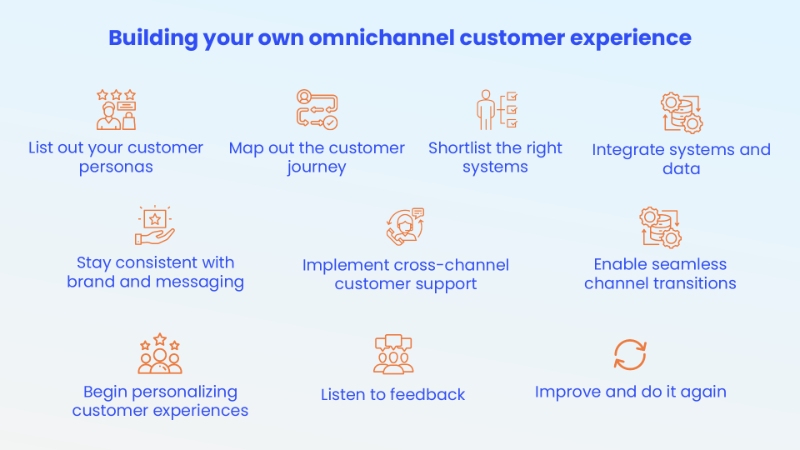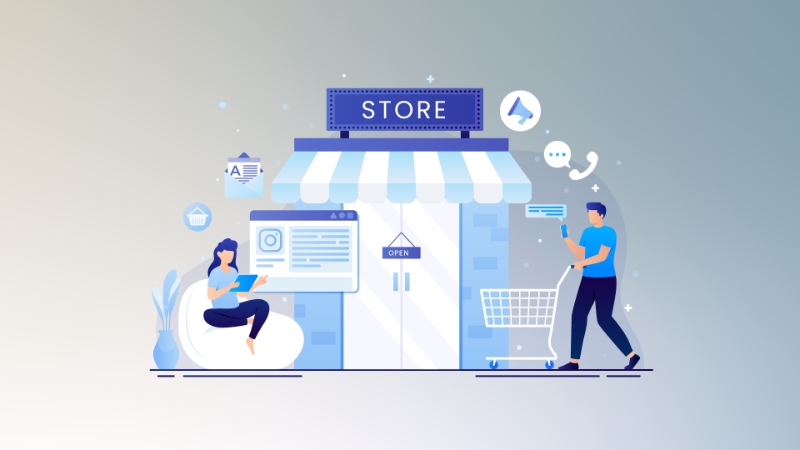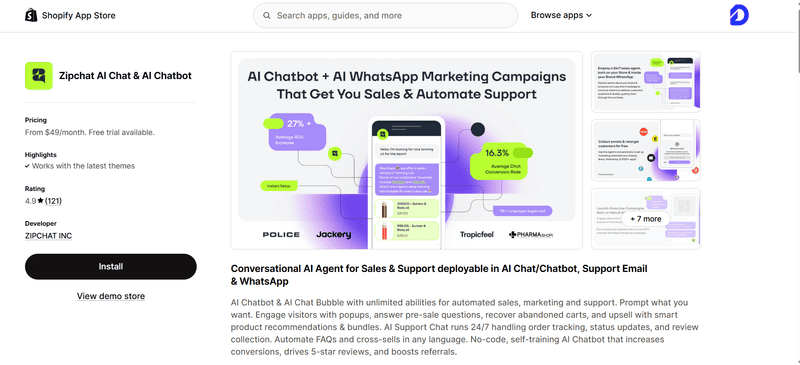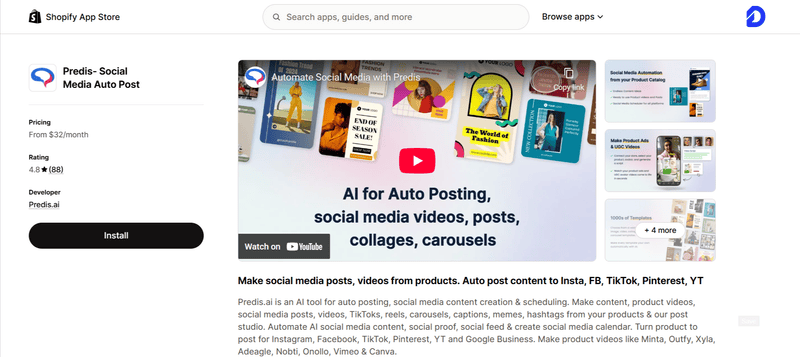
A large part of our lives now revolves around technology, and rightfully so. After all, technology has placed convenience literally at our fingertips.
Customers can now choose to engage with their favorite brands using multiple channels: social media platforms, search engines, emails, chatbots, and more. But do you, as a brand, have a strategy in place to build an omnichannel customer experience?
Let’s take a detailed look at what the omnichannel customer experience means and how you as a business can build an omnichannel customer experience.
What is an omnichannel customer experience?
An omnichannel customer experience is when a brand uses multiple communication channels to engage with its customers. The key point here, though, is to ensure the customer enjoys a seamless experience with the brand even if they switch communication channels during the course of the engagement.
Let’s illustrate this with an example. Let's suppose, for example, a customer comes across a product they like at your physical store, but chooses not to buy it right away. They then get onto your Instagram DMs to ask you questions about the product, before completing the purchase on your e-commerce store.
An omnichannel customer experience would ensure the customer has a consistent experience with your brand across all three channels. This consistency should include the level of service, branding, business language, and more.
Omnichannel vs multichannel: What’s the difference?
We understand how easy it is to confuse omnichannel experiences with multichannel experiences. The similarity between the two is that both use multiple channels to engage with customers. This could include social media platforms, emails, brick-and-mortar stores, e-commerce websites, and more.
However, a multichannel experience has each of these platforms working in different ways, or in silos. This means that, for example, their social media strategy does not necessarily have the same end goals as their email marketing campaigns do.
In an omnichannel customer experience, all these different moving parts work towards creating a single, cohesive, seamless experience for customers across all these channels.
Importance of investing in an omnichannel customer experience
Now that we know what an omnichannel customer experience is, let’s look at why it is important to invest in creating one.
Improved customer satisfaction
Enhanced customer loyalty
Increased customer engagement
Higher customer lifetime value
Streamlined customer support
Improved data collection
Adaptability to customer preferences
Boosted brand reputation and perception
Let’s break down each of the above points to get a better understanding of the benefits of building an omnichannel customer experience.
1. Improved customer satisfaction
Creating omnichannel customer experiences offers customers a seamless experience across multiple channels, and this leads to a marked increase in customer satisfaction.
Let’s break this down further. An omnichannel experience allows your staff to have a customer’s conversation history available to them irrespective of the channel of communication.
This allows your customers to have a consistent experience even if they switch from, for example, your physical store to your e-commerce website. By ensuring this consistency, you guarantee your customer walks away from their engagement with your brand feeling thoroughly satisfied.
2. Enhanced customer loyalty
As customers continue to experience high-quality, consistent engagements with your brand, their loyalty is bound to be enhanced.
In fact, a recent study showed that by creating positive omnichannel customer experiences, brands saw customer retention reach almost 91%!
3. Increased customer engagement
Different customers have their own preferences when it comes to communication channels.
An omnichannel approach to customer experiences offers customers multiple touch points to interact with the brand and guarantees them the same experience across all of them. The result? A marked increase in customer engagement.
4. Higher customer lifetime value

When customers have omnichannel experiences to guide their decision-making, brands can expect as much as a 30% increase in lifetime value than a consumer that engages only a single channel.
What this means is that a customer who engages in more than one channel with your business, such as your physical store and e-commerce website, is likely to spend 30% more during the duration of their relationship with your brand than a customer who only visits your store.
5. Streamlined customer support
Because omnichannel customer experiences give you insights into your customer’s buying behavior over all your channels, it makes it easier to streamline customer support for them.
If a customer contacts your business with an issue, anyone attending to them will instantly be able to pull up their recent purchase history and help remediate their problem.
6. Improved data collection
When you enable omnichannel customer experiences, you get access to a lot of crucial data, such as your customer’s purchase history, buying behavior, commonly faced issues, preferred channels, and more.
All of this data can help you forecast trends, intent, sentiment, and a lot more to help engage with your customers more effectively.
7. Adaptability to customer preferences
With omnichannel custom engagement giving you such deep insights into customer behavior, it becomes easy for you to tailor your offerings based on these preferences.
For example, let’s suppose a customer walked into your store and you knew what they were looking for on your e-commerce website the previous day. This would make it easier for you to steer the conversation in the right direction and help satisfy their needs more efficiently.
8. Boosted brand reputation and perception
Omnichannel customer experiences are designed to ensure customers have the luxury of being able to continue a single interaction with your brand across multiple channels without any lapses in understanding.
These experiences add a lot of value to the level of service your customers enjoy. As a result, their perception of your business changes for the better and boosts your brand reputation for good measure as well.
Building your own omnichannel customer experience
Let’s now take a look at how you can go about building your own omnichannel customer experience.

List out your customer personas
Map out the customer journey
Shortlist the right systems
Integrate systems and data
Stay consistent with brand and messaging
Implement cross-channel customer support
Enable seamless channel transitions
Begin personalizing customer experiences
Listen to feedback
Improve and do it again
Let’s get more into the details of each of these steps that go into building an omnichannel customer experience.
1. List out your customer personas
This involves understanding who your target customers are, based on their interests, their age, where they live, and other factors.
Use surveys and data intelligence to also gauge what their expectations from brands like yours are, what their buying habits are, and how this behavior is likely to change.
2. Map out the customer journey
Next, you will need to map out the customer journey. This involves answering what your customers' needs are, what an ideal customer experience should look like, and how their interactions with your business across different channels are likely to change.

3. Shortlist the right systems
Once you’ve mapped out your customer journey, you will then need to choose the systems you will use to enable the journey.
This could include social media platforms, emails, instant messaging, customer support on the phone, and more.
Keep in mind that you will need to decide what works for your business and choose those channels wisely. It isn’t always necessary to employ every available channel to build a great omnichannel customer experience.
4. Integrate systems and data
The centerpiece of a great omnichannel experience is the customer having a consistent and positive experience dealing with your business across multiple communication channels.
For this to happen, you need to integrate your e-commerce platform, social media platforms, CRM, email, and other customer support tools, giving you a unified view of all customer data.
This will make it easy for your team to track customer interactions and ensure they have great omnichannel experiences with your brand.
5. Stay consistent with branding and messaging
Another key factor in the process of building an omnichannel customer experience is in keeping branding messaging consistent across all channels.
When your branding, tone, language and messaging remain consistent across all your channels, it becomes easier for your customers to recognize your brand, and build trust in your business.
6. Implement cross-channel customer support

A positive omnichannel customer experience does more than just drive sales. A large part of that experience is ensuring customers get cross-channel customer support.
Setting this up has multiple touchpoints. Chatbots and live chat agents on your business website, an inbound call center, support on social media, instant messaging, building a self-help knowledge base, and in-store support are all aspects you will need to consider.
However, once again, for you to provide a truly omnichannel experience, your customer support team will all need access to the same customer data, irrespective of the channel.
7. Enable seamless channel transitions
Your omnichannel customer experience must be designed in a way that allows customers to seamlessly transition from one channel to the other.
A great example of this can be found in the retail industry, where some brands let their customers buy a product on their webstore, but pick it from a brick-and-mortar store without having to go through the whole process again.
8. Begin personalizing customer experiences
The next step is to research each customer’s preferences and shopping habits with your brand over a period of time so that you can personalize your offers to them.
A great example of this concept at work can be seen with Netflix. Irrespective of which device you log into, your home page, suggested watching and other viewing aspects remain the same.
9. Listen to feedback
Once you start personalizing content for customers to provide a truly seamless omnichannel experience, track the performance of the process across various metrics, including customer satisfaction, first contact resolution, and customer retention.
An integral part of this process is to directly ask customers for feedback and to take the feedback you receive seriously enough to work on them.
10. Improve and do it again
Once you know what’s working and what needs to change, work on the process again and get back at it until you have developed a truly seamless omnichannel experience.
Create the perfect omnichannel experience with Dyrect
Dyrect can help you to create the perfect post-sales omnichannel customer experience in literally no time.
Our one-click solution for warranty adoption also gives you crucial first-party data. This data allows you to open up communication with your customers using multiple channels.
Our no-code builder allows you to build social media engagements, upsell products, and more in a matter of minutes.
Tailor your omnichannel experience based on the analytics and smart data that we’ll make available to you, covering everything from product performance, where your customers are located, buying trends, and more.
Want to learn more about how Dyrect can help you build the perfect omnichannel experience? Book a demo with our experts today!



